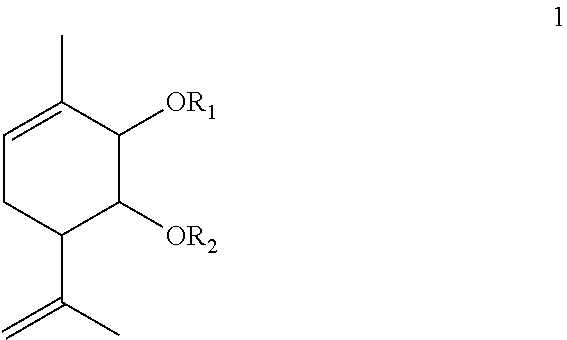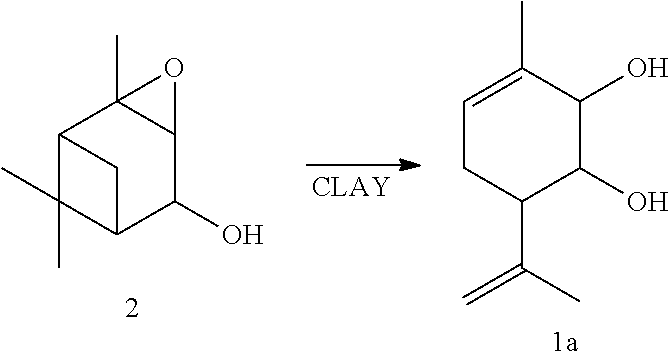Agent for treating Parkinson's disease
a technology for parkinson disease and agents, applied in the field of medicine, can solve the problems of low effectiveness, reduce the mortality associated with parkinson disease, and reduce the efficiency of parkinson disease, and achieve the effect of remarkable anti-parkinson activity
- Summary
- Abstract
- Description
- Claims
- Application Information
AI Technical Summary
Benefits of technology
Problems solved by technology
Method used
Image
Examples
example 1
Synthesis of 3-methyl-6-(1-methylethenyl)cyclohex-3-ene-1,2-diol1a using askanite-bentonite clay
[0030]
[0031]A solution of 0.2 g of verbenole epoxide 2 in 7 ml CH2Cl2 was added into a suspension of 0.5 askanite-betonite clay (calcinated for 3 hours under 120° C.) in 8 ml CH2Cl2. The mixture was mixed for 40 minutes under 20° C. 5 ml of diethylether was then added. The catalyst was filtered, the solvent evaporated. The obtained reaction mixture was separated in a column with 10 g of silicate gel, a solution of diethyl ether in hexane 10 to 90% was used as an eluent. 0.094 g (47%) of 3-methyl-6-(1-methylethenyl)cyclohex-3-ene-1,2-diol 1a was obtained as a result.
example 2
Synthesis of (1R,2R,6S)-3-methyl-6-(1-methylethenyl)cyclohex-3-ene-1,2-diol ((1R,2R,6S)-1a) with ee 60% using K10 clay
[0032]
[0033]A solution of 11.5 g of epoxide (−)-cis-verbenole (1R,2R,4S,5R,6S)-2 ([α]58020=−44 (c 12, CHCl3)) in 150 ml CH2Cl2 was added, stiffing continuously, into a suspension of 30 g K10 (Fluka) clay (calcinated for 3 hours under 110° C.) in 200 ml CH2Cl2. The reaction mixture was stirred for 1 hour under 22° C. The catalyst was filtered, rinsed by ethyl acetate, the solvent was evaporated. The residue was separated by column chromatography using silicate gel, a solution of ethyl acetate in hexane 5 to 100% was used as an eluent. 5.10 g (44%) of (1R,2R,6S)-3-methyl-6-(1-methylethenyl)cyclohex-3-ene-1,2-diol ((1R,2R,6S)-1a) (ee 60%, [α]58020=−46(c 18, CHCl3)) was obtained as a result. Enantiomeric purity of the compound 1a was evaluated by the data of gas-liquid chromatography with mass spectroscopy in chiral column.
example 3
Synthesis of (1R,2R,6S)-3-methyl-6-(1-methylethenyl)cyclohex-3-ene-1,2-diol ((1R,2R,6S)-1a) with ee 94% using K10 clay
[0034]
[0035]A solution of 945 mg epoxide (−)-cis-verbenole (1R,2R,4S,5R,6S)-2 ([α]D25=−85.6 (c0.82, CHCl3)) in 12 ml methylene chloride was added, stiffing continuously, into a suspension of 2 g K10 (Fluka) clay (calcinated for 3 hours under 110° C.) in 15 ml of methylene chloride. The reaction mixture was stirred for 1 hour under room temperature. The catalyst was filtered, rinsed by ethyl acetate, the solvent was evaporated. The residue was separated by column chromatography using SiO2 (60-200μ; Merck), a solution of diethyl ether in hexane 5 to 100% was used as an eluent. 270 mg (29%) of (1R,2R,6s)-1a (ee 94%, ([α]D27=−84.0 (c 3.47, CHCl3)) was obtained as a result. Enantiomeric purity of the compound 1a was evaluated by the data of gas-liquid chromatography with mass spectroscopy in chiral column.
PUM
| Property | Measurement | Unit |
|---|---|---|
| enantiomeric excess | aaaaa | aaaaa |
| weight | aaaaa | aaaaa |
| speed | aaaaa | aaaaa |
Abstract
Description
Claims
Application Information
 Login to View More
Login to View More - R&D
- Intellectual Property
- Life Sciences
- Materials
- Tech Scout
- Unparalleled Data Quality
- Higher Quality Content
- 60% Fewer Hallucinations
Browse by: Latest US Patents, China's latest patents, Technical Efficacy Thesaurus, Application Domain, Technology Topic, Popular Technical Reports.
© 2025 PatSnap. All rights reserved.Legal|Privacy policy|Modern Slavery Act Transparency Statement|Sitemap|About US| Contact US: help@patsnap.com



